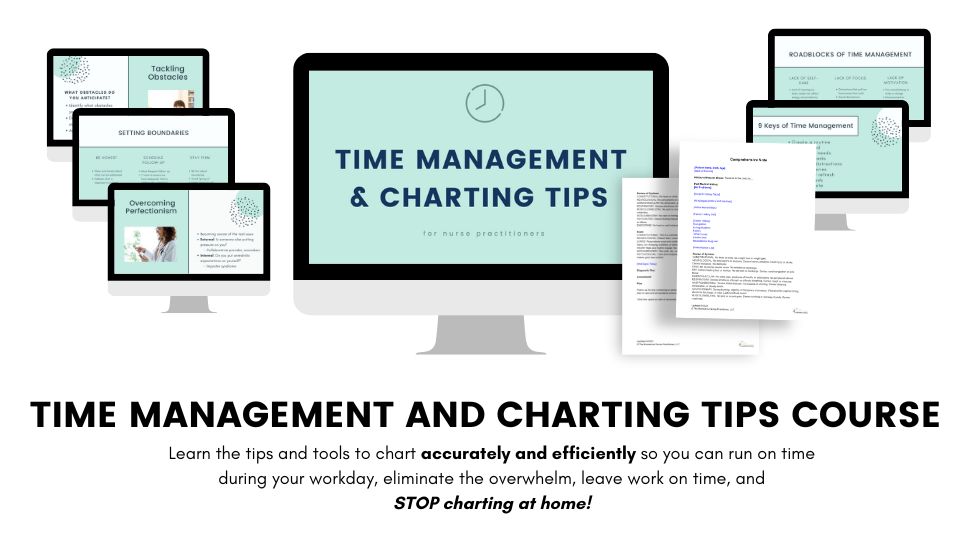A SOAP note is a format for writing a patient encounter visit that is commonly used by nurse practitioners (and many healthcare providers) to document patient care. The basic components of a SOAP note are universal and can be used for many different specialties.
But creating a SOAP note can be difficult! If you have never heard of a SOAP note, this article will give you some examples of a SOAP note and also discuss seven tips for nurse practitioners to utilize while charting!
Components of a SOAP note
Here is a quick overview of the components of a SOAP note. **For a complete breakdown, read this article: How to write a SOAP note: 4 basic components of a chart note.
The acronym SOAP stands for subjective, objective, assessment, and plan.
S- Subjective: Information provided by the patient, family, etc.
- Chief complaint
- History of present illness
- Past medical history
- Allergies
- Medications
- Review of systems
O- Objective: Information that is measured or observed.
- Vital signs
- Physical exam
- Diagnostic data
A- Assessment: Summary of subjective and objective data
- Diagnoses
- Differential diagnoses
- Reasoning for diagnoses/nurse practitioner’s thoughts
P- Plan: Plan of care created by the healthcare provider
- Instructions to the patient
- Medications
- Referrals
- Follow-up appointments
Tips to writing a SOAP note
The SOAP note format creates a systematic, easy to follow chart note. But knowing how to create an easy to read note is harder than it looks! We will go through some tips for creating a SOAP note. Then look at the examples of a SOAP note to see how this format is applied.
Remember the 3 reasons nurse practitioners chart.
Nurse practitioners create chart notes for three reasons. Chart notes are created for continuation of care, billing/coding, and to avoid legal implications. The SOAP notes we create should adhere to all three of these aspects.
Use clear and concise language.
Use simple, concise language that is easy to understand. Avoid medical jargon, acronyms, and abbreviations that may be confusing to patients or other healthcare professionals.
Be informative.
Remember that your SOAP note may be used by other healthcare providers in the future. Be thorough in your documentation, including all relevant information about the patient’s condition, treatment, and progress.
Be objective.
Stick to the facts and avoid making assumptions or judgments about the patient’s behavior or motivations. Avoid any negative or accusing terminology about the patient.
Avoid over charting.
Not only does overcharging consume a lot of the nurse practitioner’s time, it can actually have negative impacts. Remember less is more. For example, if you mention something in the history of present illness, it needs to be addressed through the objective, assessment, and plan. Appropriate evaluation and treatment needs to ensue. Take a look at this article written by The Elite Nurse Practitioner- Charting: Less is More!
Review and revise.
Take the time to review and revise your note before finalizing it. Make sure that all sections are complete, and that your documentation is accurate and clear. Quickly check for spelling or grammar errors. It is important for nurse practitioners to create professional chart notes.
Avoid charting inconsistencies.
Nurse practitioners can prevent a negative outcome in a malpractice cause by avoiding charting inconsistencies. Pay attention to any incorrect information such as erroneous vital signs. A blood pressure of 170/62 is much different than 70/62. Take a couple extra minutes to look over and change any inconsistencies.

Examples of a SOAP note.
These are just examples of a SOAP note. Remember the SOAP note is just a format for writing a patient encounter note. Look at these examples of a SOAP note and see how easy it is to follow the format!
Examples of a SOAP note #1
SUBJECTIVE
Chief complaint and history of present illness: 55-year-old female presents to the clinic for 6 month follow-up of hypertension and hyperlipidemia. Taking lisinopril 10mg daily and tolerating well. Home blood pressures 120/80. Tolerates atorvastatin 20mg daily. Reports improvement of low carb, low fat diet. Exercising 30 minutes 4 x week.
Past medical history: Hypertension and hyperlipidemia
Allergies: NKDA
Medications: Lisinopril 10 mg daily, atorvastatin 20mg daily
Review of systems:
CONSTITUTIONAL: No fever or chills. No weight loss or weight gain.
NEUROLOGICAL: No headaches.
EYES: No blurred or double vision.
CARDIOVASCULAR: No chest pain, shortness of breath, or palpitations. No peripheral edema.
RESPIRATORY: Denies shortness of breath or difficulty breathing. Denies cough.
GASTROINTESTINAL: Denies abdominal pain. No nausea or vomiting. Denies diarrhea or constipation.
MUSCULOSKELETAL: No joint or muscle pain. Denies swelling or redness of joints.
INTEGUMENTARY: No rash or itching. Denies wounds or lesions.
OBJECTIVE
Vital signs– Temp: 98.1 F, HR 65 bpm, BP 118/76, RR 18 resp/min, O2 sat 98% on room air
Exam:
CONSTITUTIONAL: This is a well-developed, well-nourished, adult male. No acute distress.
NEUROLOGICAL: Patient alert, orientated, memory intact.
LUNGS: Respirations even and unlabored, chest expansion symmetrical. Lung sounds clear in all lobes, no wheezing, crackles, or adventitious breath sounds.
HEART: Rate and rhythm regular. No cardiac murmur, click, or rub noted.
ABDOMEN: Soft, nontender. Bowel sounds active in all four quadrants.
MUSCULOSKELETAL/EXTREMITIES: Extremities are intact, no redness or edema noted of upper or lower extremity.
INTEGUMENTARY: Skin pink, dry, warm to touch. No rash, wounds, lesions noted on visible skin.
PSYCHOSOCIAL: Calm and cooperative, interacts appropriately with staff.
Diagnostic test:
Fasting lipid panel: Total cholesterol 160, triglycerides 130, HDL 60, LDL 80
ASSESSMENT:
Essential hypertension- controlled
Hyperlipidemia- controlled
PLAN:
Lipid panel stable. Blood pressure at goal. Refills of lisinopril 10mg daily and atorvastatin 20mg daily sent to Pharm Pharmacy. We discussed DASH diet and importance of exercise for management of HTN and hyperlipidemia. Follow-up in 6 months or sooner if needed. Patient verbalizes understanding regarding plan of care and all questions answered.
Examples of a SOAP note #2
SUBJECTIVE
Chief complaint and History of present illness: 24-year-old male presents to the clinic for complaints of left ankle pain. Patient was playing basketball when she laterally rolled ankle. Reports 10/10, sharp pain. Difficulty bearing weight. Denies numbness or tingling. Swelling and bruising but no open wounds. Event occurred 15 minutes before presentation to clinic and unable to take OTC analgesics.
Past medical history: No past medical history
Allergies: NKDA
Medications: No current home medications
Review of systems:
As noted in HPI.
OBJECTIVE:
Vital signs– Temp: 98.1 F, HR 88 bpm, BP 120/80, RR 18 resp/min, O2 sat 98% on room air
Exam:
CONSTITUTIONAL: This is a well-developed, well-nourished, adult female.
NEUROLOGICAL: Patient alert, orientated, memory intact. Dull and sharp sensation to bilateral feet present and equal bilaterally.
LUNGS: Respirations even and unlabored, chest expansion symmetrical.
MUSCULOSKELETAL/EXTREMITIES: Extremities are intact. Swelling and tenderness to lateral left ankle. Mild joint instability noted with passive range of motion of left ankle. Cap refill less than 3 seconds.
INTEGUMENTARY: Skin pink, dry, warm to touch. Ecchymosis to left ankle. No open wounds noted.
PSYCHOSOCIAL: Patient becomes tearful during exam but overall cooperative, interacts appropriately with staff.
Diagnostic test:
X-ray left ankle: Normal bone alignment. No sign of acute fracture. Read by myself.
ASSESSMENT:
Left ankle Grade 2 sprain
PLAN:
Ankle wrapped with Ace bandage and patient fitted for air cast splint. Instructed the patient to rest for two weeks, then activity as tolerated. Ice, and elevate as much as possible. Take Tylenol and ibuprofen for pain. Follow-up for worsening or persistent symptoms. Patient verbalizes understanding regarding plan of care and all questions answered.
Remember these are just examples of a SOAP note, but I hope you can see how easy it is to write a note using this format! Working as a nurse practitioner can feel overwhelming and the charting can be time consuming. But utilizing a SOAP note format can make it easy to write and read!
When it comes to charting, The Nurse Practitioner Charting School is the one stop for all documentation resources created specifically for NPs!
- Check out The Nurse Practitioner Charting School’s blog page for helpful charting tips!
Also checkout the paid courses:
- Time Management and Charting Tips Course : Learn the tips and tools to chart accurately and efficiently so you can run on time during your workday, eliminate the overwhelm, leave work on time, and STOP charting at home!
- Billing and Coding Course: Outpatient Visits : Feel confident choosing the correct Evaluation and Management CPT® code for an outpatient patient visit, so you can avoid over coding (and under coding!) ensuring you receive proper insurance reimbursement!
- Legal Issues with Charting Course : Learn how to prevent a malpractice suit and put your mind at ease regarding legal issues of charting.
- Charting as a Nurse Practitioner Student Course: Going through nurse practitioner school is incredibly overwhelming. Don’t stress about the charting.
Utilize The NP Charting School’s Comprehensive List of Smart Phrases : Get access to over 100 smart/dot phrases to save time so you can STOP charting at home!

Erica D the NP is a family nurse practitioner and The Nurse Practitioner Charting Coach. Erica helps nurse practitioners STOP charting at home! Erica created The Nurse Practitioner Charting School to be the one stop for all documentation resources created specifically for nurse practitioners. Learn more at www.npchartingschool.com
Follow on Facebook: The Nurse Practitioner Charting SchoolAnd on Instagram: @npchartingschool
Free training: 4 charting tips to help nurse practitioners get their time back! Sign up here!



